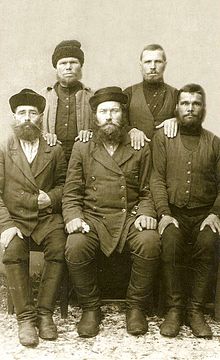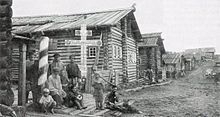Pomors
You can helpexpand this article with text translated fromthe corresponding articlein Russian.Click [show] for important translation instructions.
|
| Total population | |
|---|---|
| 2232 (2020 census)[1] | |
| Regions with significant populations | |
| Languages | |
| Dialect ofRussian:Pomor dialects | |
| Religion | |
| Eastern Orthodox Christians,Starovers | |
| Related ethnic groups | |
| Russians,Komi,Sami,Vepsians,Norwegians |

PomorsorPomory(Russian:помо́ры,lit. 'seasiders',Russian pronunciation:[pɐˈmorɨ]) are anethnographic groupthought to be descended fromRussiansettlers (primarily fromVeliky Novgorod) according to traditional Russian historiography, living on theWhite Seacoasts and the territory whose southern border lies on a watershed which separates the White Sea river basin from the basins of rivers that flow south.[2][3]Genetically, though, they are more closely related toindigenousUralicethnicities of the area and show no affiliations toNovgorodpopulations.[4][5][6]
History
[edit]As early as the 12th century, explorers fromNovgorodentered the White Sea through theNorthern Dvina,Mezen,PechoraandOnegaestuaries and founded settlements along the sea coasts ofBjarmaland.Kholmogoryserved as their chief town until the rise ofArkhangelskin the late 16th century. From their base atKola,they explored theBarents Regionand theKola peninsulaandNovaya Zemlya.
Later the Pomor discovered and maintained theNorthern Sea Routebetween Arkhangelsk andSiberia.With their ships (koches), the Pomors penetrated to the trans-Uralareas of Northern Siberia, where they founded the settlement ofMangazeyaeast of theYamal Peninsulain the early 16th century. Tatyana Bratkova has reported that some historians speculate that in the early 17th century, Pomors settled the isolated village ofRusskoye Ustyein thedeltaof theIndigirka,in north-easternYakutia.[7]

The name of the Pomors derives from thePomorsky(literally, "maritime" ) coast of the White Sea (betweenOnegaandKem), having the root ofmore(море,meaning "sea"; derived from anIndo-European root). The same root appears in the toponymPomerania(Polish:Pomorze) andArmorica(Gaulish:Aremorica) and also in the Gaulish ethnonymMorini.
The termPomor,which in the 10th–12th centuries meant "a person who lived near sea", gradually was extended into one to apply to this population living relatively far away from the sea. Finally in the 15th century, the people became disconnected from the sea. The sea was not a major part of economy of this region. At the same time, people began using the term Pomor'e to refer to a territory of practically the whole European Russian North, including theMurmansk,ArkhangelskandVologdaregions; andKareliaandKomirepublics.[8]
The traditional livelihoods of the Pomor based on the sea included animal hunting,whalingand fishing; intundraregions they practicedreindeerherding. The Pomortraded by seain corn and fish with NorthernNorway,which became important to both sides. This trade was so intensive that a kind of Russian-Norwegianpidgin languageMoja på tvoja(orRussenorsk) developed on the North Norwegian coast that was used from 1750 to 1920.[9]

In the 12–15th centuries, Pomor'e was considered an extensive colony of the state ofVeliky Novgorod.By the early 16th century the annexation of Pomor'e byMoscowwas completed. In the 17th century, in 22 Pomor'e districts, the great bulk of the population consisted of free peasants. A portion of the land belonged to monasteries and to the Stroganov merchants. There were no landlords in Pomor'e. The population of Pomor'e districts was engaged in fishing, mica and salt production (Sol'-Kamskay, Sol'- Vychegodskay, Tot'ma, etc.) and other enterprises.

The RussianBrockhaus and Efron Encyclopedic Dictionary,in its 1890–1907 edition, classified Pomors as Great Russians or referred to them as Russian traders and trappers of the North. To date, no encyclopedia or encyclopedic dictionary refers to the Pomor as a separate ethnic group.
In the 2002census,respondents had the option to identify as "Pomors", this group being tabulated by the census as a subgroup of theRussianethnicity. However, only 6,571 persons did so, almost all of them inArkhangelsk Oblast(6,295) andMurmansk Oblast(127).
Religion & worldview
[edit]Pomors are mostlyOrthodox Christiansin faith. Prior to theRevolution of 1917a large percentage of Russians from Pomorje (or Pomors) were practicingOld Believers,[10]thePomorian Churchstill has around 400 thousand members.[11]Pomor Christianity has traditionally coexisted and been infused with ananimism,which is based on sacral geography, in asyncreticmanner, resulting in a strongenvironmental ethic.This led to the classification of certain animals like thebeluga whaleas holy and resistance to modern fishing techniques in the 20th century.[12]
Pomor worldview
[edit]As part of the broader category of "cold societies" that are based around the concept of eternal return like the neighboringSami,NenetsorKomithe Pomor worldview reflects a complex interaction between ancient piety,shamanism,and ritualistic practices aimed at maintaining homeostasis within their communities. This homeostasis however, is an active and fluid concept called dynamic constancy and does not represent absolute standstill. The Pomors believed that preserving the static structure of their society was essential for survival in the environment ofPomorye,where the poet-storyteller (starinshchik) as a keeper of "deified memory" played a key role in maintaining this balance through mythopoetic expression.[13]
The passage from winter to summer was culturally connected to rebirth and rituals like making a sacrificial vow to the "sea god" Nikola Morsky and celebrating the farewell to sea like a funeral played a key role in the light of these philosophical elements. During the main holiday, the conjunction of Old and New Year, the demiurge defeats the bearer of chaos and death each year anew, emphasizing the concept of cyclical time and eternal return. The total sacrifice and descend into chaos which leads to the poiesis of a new world is all-encompassing and does not only apply to people, but alsogodsandbeasts.[13]
These spiritual beliefs also played a large role in daily life, as it is a part of the "Pomor fate" to actively engage in this battle, which is not only shabed by actions but also the words of theshamanor starinshchik, the person who has knowledge of the ritual turns of speech and sacred formulas. The winter is considered adreamtime,which is ended by localized celebrations of symbolic rebirth that greet the sun[13],which plays a key role in Pomor mythology as it is also represented by theBird of Happinessin Pomor households[14].
One of the critical aspects of the Pomor spiritual world was the sacred status of the bathhouse, which was viewed as an archaic sanctuary-temple. Thebathhouseplayed a central role in initiatory and medical rituals that symbolized the "second birth" of a person, just like the festivals connected to the sun. The connection between thebathhouseand the forge is notable, as both were considered marginal spaces associated with transformation and rebirth, drawing from their symbolic links tofireandwater.The sacred geography of the Pomors placed thebathhouseon the periphery of the settlement, reinforcing its chthonic associations with both life and death.[15]
The sea, central to Pomor life, held a significant mythopoetic meaning as a threshold between the world of the living and the world of the dead. This view of the sea as a boundary endowed navigation with profound religious significance. The Pomors regarded the northeast wind, or "polunoshnik," as asacredforce, connecting themundaneworld to the mystical realms of the North, where contact with the otherworldly was inevitable. The sea, with its destructive and creative powers, was perceived as both a source of chaos and a pathway to salvation, reflecting the dual nature of the northern lands adjacent to the Polar Mountain, which were simultaneously regions ofheavenandhell[16].
As the last two elements show, the combination of destruction and creation, life and death, or even the sacred and the mundane at the same time instead of a clear cut separation of dual forces like good and evil, is pivotal to Pomorphilosophy,reminiscent of concepts likeYin and Yang.This highlights the importance ofliminal spacesand thresholds. Even the sacred always has a dark side which is in this case represented by the "guardians of the threshold" while the "axis of the world" or "northern mountain" which was believed to exist behind the sea was recognized as aparadise.However, it is not possible to enter the realm of the sacred without experiencing its ambivalence and dark aspects, represented by the guardians. Elements like the "wind rose", which helped Pomor sailors navigate, were also considered to be sacred knowledge.[16]
The concept of islands also held a sacred significance in Pomor rituals, particularly in burial and memorial practices. Islands were seen as chthonic spaces that connected the living with the ancestors, ensuring the stability of the ethnic group’s sacred traditions. In Pomor belief, these island-topos served as symbolic models of the universe, where the three co-temporal and co-spatial domains of the dead, the living, and the descendants intersected, creating a space where the past, present, and future were fused into a single continuum. Ritual remembrance, particularly through the act of memorial rites conducted on these islands, reinforced the eternal memory of the ancestors and the sacred geometry of the cosmos, thereby preserving the cultural identity of the Pomors.[16]
Present day use of the name
[edit]One of the three universities of Arkhangelsk was named the Pomor State University (now merged intoNorthern (Arctic) Federal University). In line with the current Russian trend towards amalgamating the least populatedfederal subjectsinto larger entities, a merger of Arkhangelsk and Murmansk Oblasts, theKomi Republic,and theNenets Autonomous Okrughas beenproposed,one of the possible names of this new territory being the Pomor Krai.
Notable Pomors
[edit]
- Mikhail Lomonosov(1711–1765), polymath, born nearKholmogory[17]
- Fedot Shubin(1740–1805), sculptor, born nearKholmogory
- Valery Leontiev,pop singer.
See also
[edit]- Russian North
- Pomor dialects
- Boris Shergin
- Laughter and Grief by the White Sea,a film celebrating the Pomors' culture.
- Pomor trade
- Barentsburg Pomor Museum
References
[edit]- ^"Росстат — Всероссийская перепись населения 2020".rosstat.gov.ru.Archived fromthe originalon 2020-01-24.Retrieved2023-01-03.
- ^Alexandrov, V.A.; Vlasova, I.V.; Polishchuk, N.S., eds. (1997).Русские[The Russians](N.N. Miklukho-Maklai Institute of Ethnology and Anthropology RAS)(in Russian). Moscow:Nauka.p. 109.ISBN5-02-010320-9.Archivedfrom the original on 2013-03-25.Retrieved2021-08-03.
- ^Teriukov, A.I. (2016)."Поморы"[Pomors].Большая российская энциклопедия/Great Russian EncyclopediaOnline(in Russian). Archived fromthe originalon 2022-09-09.Retrieved2021-08-04.
- ^Evseeva, I.; Spurkland, A.; Thorsby, E.; Smerdel, A.; Tranebjaerg, L.; Boldyreva, M.; Groudakova, E.; Gouskova, I.; Alexeev, L. L. (2002)."HLA profile of three ethnic groups living in the North-Western region of Russia".Tissue Antigens.59(1): 38–43.doi:10.1034/j.1399-0039.2002.590107.x.ISSN0001-2815.PMID11972877.
- ^"Peculiarity of Pomors of Onega Peninsula and Winter Coast in the genetic context of Northern Europe".
- ^v. s, Okovantsev; g. y, Ponomarev; a. t, Agdzhoyan; v. y, Pylev; e. v, Balanovska (2022)."Peculiarity of Pomors of Onega Peninsula and Winter Coast in the Genetic Context of Northern Europe".Bulletin of Russian State Medical University(5): 5–14.
- ^Bratkova, Tatyana (1998)."Russkoye Ustye"Archived2019-06-19 at theWayback Machine.Novy Mir,no. 4(in Russian)
- ^"Pomors and Pomor'e".Archived fromthe originalon 2008-09-10.Retrieved2008-09-10.
- ^Minaeva T.S., Karelin V.A.Language contacts between Pomors and Norwegians during expeditions to Svalbard in the second half of the 18th — first half of the 19th centuries.Arktika i Sever [Arctic and North], 2020, no. 38, pp. 140–151. DOI: 10.37482/issn2221-2698.2020.38.140.
- ^"The Pomors – Barentsinfo".Archivedfrom the original on 2020-02-15.Retrieved2019-07-03.
- ^Агеева Е. А.Древлеправославная поморская церковь//Православная энциклопедия.—М.,2007. — Т. XVI: «Дор—Евангелическая церковь союза». — С. 135—144. — 752 с. — 39,000 экз. — ISBN 978-5-89572-028-8.
- ^Brain, Stephen (October 2011)."The Christian environmental ethic of the Russian Pomor".
- ^abc"Мифопоэтические Аспекты Традиционной Поморской Криософии И Антропологии Холода: Реконструкция И Интерпретация".Вестник Северного (Арктического) Федерального Университета. Серия: Гуманитарные И Социальные Науки(4): 122–133. 2021.
- ^"Bird of Happiness".Mar 5, 2016. Archived fromthe originalon 2016-03-05.
- ^"Топос бани в религиозной антропологии народов северной России".Вестник Северного (Арктического) Федерального Университета. Серия: Гуманитарные И Социальные Науки(4): 138–146. 2019.
- ^abc"Образно-символический фонд сакральной океанографии народов моря (часть 1)".Вестник Северного (Арктического) Федерального Университета. Серия: Гуманитарные И Социальные Науки(1): 106–113. 2020.
- ^https://narfu.ru/lomonosov/about/nordic_scientists/files/articles/enLomonosov_Pages_of_his_Biography.pdfArchived2020-08-06 at theWayback Machine[bare URL PDF]
External links
[edit]- Pomors, definition, Efremova Academic Dictionary, Russian
- Pomors, definition, Большой Энциклопедический Словарь, Great Encyclopedic Dictionary, Russian
- Pomors, definition, Ushakov's Encyclopedic Dictionary, Russian
- Brockhaus & Efron, Encyclopedia, 1890–1907, Russian
- Pomor State University at Archangel / Arkhangelsk, Russian
- Tatiana Shrader Across the Borders: the Pomor Trade, English
- Pomormuseet i Vardø -Pomor Museum in Vardø, Norwegian and Russian
- Pomorje and Pomors, different types within Russian nation, the origins, in Russian


